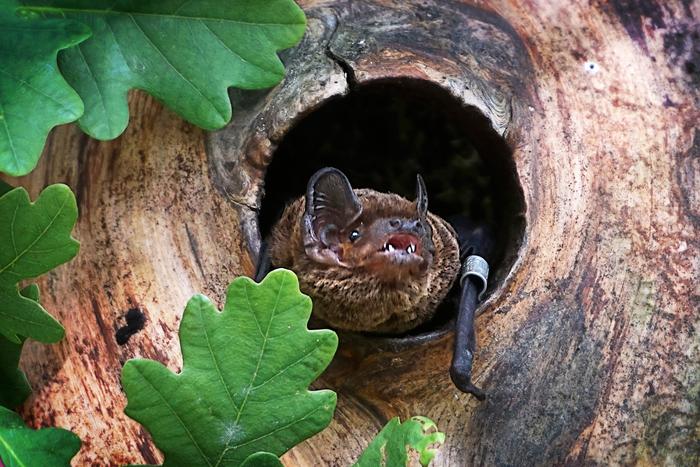Leisler’s Bat Reveals Alarming Shifts in Habitat Use Amid Forest Management Changes
In the heart of Europe, a subtle yet profound transformation is unfolding within the lives of one of the continent’s native bat species, the Leisler’s bat (Nyctalus leisleri). Traditionally a forest specialist, this species increasingly finds its natural habitats compromised by ongoing forestry practices. Researchers equipped with high-resolution GPS technology have illuminated previously unseen aspects of these bats’ habitat use, revealing a critical dependence on old, structurally complex forests, particularly oak woodlands, and a growing tendency to seek refuge in urban environments.
With over 1,400 species globally, bats represent an exceptionally diverse mammalian group, many of which in Central Europe historically rely on dense deciduous forests rich in hollow trees for shelter and roosting. The Leisler’s bat embodies this dependence, typically nesting in tree cavities created by natural decay or woodpecker activity. However, intensification of forest management has given rise to monocultural plantations dominated by conifers such as pines and spruces—habitats poorly suited for these bats. This shift has placed immense pressure on their customary roosting sites, undermining population resilience.
Groundbreaking research led by the Leibniz Institute for Zoo and Wildlife Research adopted state-of-the-art GPS telemetry to track 32 adult Leisler’s bats in Germany’s Brandenburg region. This pioneering approach provided an unprecedented window into their daily movements and habitat preferences. The GPS-generated data allowed researchers to cross-reference the bats’ precise foraging and roosting locations with detailed landscape maps, including forest tree species compositions and small-scale habitat features such as hedgerows and copses.
The results unequivocally demonstrate a preference for structurally rich oak forests, revealing these habitats as critical for both roosting and foraging. In contrast, spruce-dominated coniferous forests were significantly avoided. Oak trees’ highly heterogeneous structure, characterized by abundant cavities and fissures, provides crucial shelter particularly for maternity colonies and daytime roosting. This ecological specificity corroborates why the loss of such habitats severely threatens the species.
Of particular concern is the bats’ increasing colonization of urban and suburban green spaces. The data indicate that Leisler’s bats frequently occupy old hollow trees in residential areas and historic buildings such as churches, effectively adapting to anthropogenic landscapes. This shift likely arises from a scarcity of suitable tree cavities in intensively managed forests, forcing bats to exploit alternative refuges. Urban green spaces thus serve a vital conservation role, offering critical roosting habitats when natural forests fall short.
The expansion of urban roosting underscores the broader implications of intensive forestry practices that favor fast-growing, economically valuable tree species over structurally complex deciduous woodlands. Modern forestry methods, which often involve the removal of old trees and deadwood, inadvertently reduce habitat complexity essential to forest-dependent species. Consequently, ecological degradation is compounded, leaving bats vulnerable to a cascade of threats.
Sustainable forestry practices emerge as a pivotal strategy to mitigate habitat loss for the Leisler’s bat. Experts advocate for management that retains old trees, promotes species and structural diversity, and prolongs forest growth periods prior to harvesting. Such interventions not only support biodiversity but can be balanced with timber production goals through careful planning and selective extraction. Additionally, urban planning must integrate conservation perspectives by protecting aging trees and historic structures that provide indispensable roosting opportunities.
Another formidable risk confronting Leisler’s bats is the increasing deployment of wind turbines, particularly within forested landscapes. Research suggests that these bats are attracted to turbines, possibly mistaking the tall structures for large trees suitable for roosting. This misperception leads to fatal collisions with turbine blades, imposing significant mortality risks. Understanding the movement ecology of this highly mobile species is crucial for informing the siting of wind energy infrastructure to minimize adverse effects.
Collaboration among ecologists, foresters, urban planners, and renewable energy stakeholders is essential to reconcile conservation with societal development. Integrating fine-scale movement data into landscape management plans enables evidence-based decisions that respect species’ ecological needs. For instance, avoiding turbine placement near key roosts or dense deciduous woodlands can substantially reduce bat fatalities.
The findings from Brandenburg offer a compelling case study illustrating how modern technology can inform species conservation in an era of rapid environmental change. By capturing detailed spatial behavior, the research transcends traditional habitat assessments, revealing nuanced patterns of habitat selection and highlighting the critical value of non-forest refuges. These insights emphasize that conserving forest specialists requires a broad landscape perspective, incorporating both natural and human-modified habitats.
As this research underscores, forests are not merely collections of trees but intricate ecosystems whose structural attributes critically influence biodiversity. For forest-dependent bats like Nyctalus leisleri, structural diversity equates to survival, dictating access to shelter, foraging resources, and safe migratory corridors. Recognizing and preserving this complexity amid economic and energetic pressures poses a pressing challenge for conservationists worldwide.
In summary, the persistent decline of old, hollow-bearing trees in managed forests and the proliferation of wind turbines within bat habitats threaten to undermine the viability of Leisler’s bat populations. However, the species’ adaptability to urban green spaces offers a hopeful avenue for mitigating habitat loss. By harmonizing sustainable forestry, urban conservation, and wildlife-sensitive renewable energy planning, it is possible to create a mosaic of habitats that support forest specialists despite anthropogenic transformations.
The research conducted by the Leibniz Institute and its collaborators thus provides a vital template for conserving forest-affiliated bat species across Europe. It calls for a paradigm shift in landscape management that embraces multi-faceted, data-driven approaches to ensure these enigmatic mammals continue to thrive amid evolving environmental and societal contexts.
Subject of Research: Animals
Article Title: Oak woodlands and urban green spaces: Landscape management for a forest-affiliated bat, the Leisler’s bat (Nyctalus leisleri)
News Publication Date: 26-May-2025
Web References: http://dx.doi.org/10.1016/j.jenvman.2025.125753
Image Credits: Photo by Carolin Scholz
Keywords: Leisler’s bat, Nyctalus leisleri, forest management, oak woodland, urban green spaces, bat telemetry, habitat conservation, sustainable forestry, wind turbine impacts, bat roosting behavior, biodiversity, wildlife management




